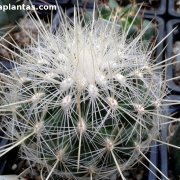Care of the cactus Thelocactus conothelos or Echinocactus conothelos |
|
The genus Thelocactus, family Cactaceae, includes about 10 species of cacti native to Mexico and the southwestern United States. Some species are: Thelocactus conothelos, Thelocactus hexahedrophorus, Thelocactus bicolor, Thelocactus setispinus, Thelocactus nidulans, Thelocactus lophothele. Scientific synonyms: Echinocactus conothelos, Gymnocactus conothelos. This species is native to northeastern Mexico. They are slow-growing cacti with a globose body when young (it becomes cylindrical with age) that reach 15 cm (5.9") in height. They have 12 ribs with conical tubercles and white areoles with 7-14 white radial spines and 1-4 thicker central spines, also white. The flowers measure 5 cm (1.96") in diameter and can be white or purple-pink. They bloom in summer. Echinocactus conothelos is used in pots for patios, terraces, balconies and windows, as indoor and greenhouse plants. Thelocactus conothelos prefers full sun exposure and a hot, dry climate. It does not resist temperatures below 4 ºC (39.2 ºF). The soil can be a commercial cacti substrate with 20% coarse sand or a mixture of equal parts leaf mulch or heather soil and coarse siliceous sand. The transplant is done in early spring if the pot has become too small. Water once every 15 days in spring, once a week in summer, once a month in autumn and do not water in winter. Fertilize once in early spring with mineral fertilizer for cacti. Thelocactus conothelos does not need pruning. Gymnocactus conothelos can be attacked by mealybugs indoors if the ventilation is not adequate. Easily propagated from seed sown in spring in slightly moist sandy seedbed. |
Images of the cactus Thelocactus conothelos or Echinocactus conothelos |
Find plants
Thelocactus conothelos or Echinocactus conothelos | Care and Growing
© 2026 FavThemes


